2000 January
For several years, airBaltic’s fleet consists of three Avro RJ70 and three Fokker 50 aircraft.
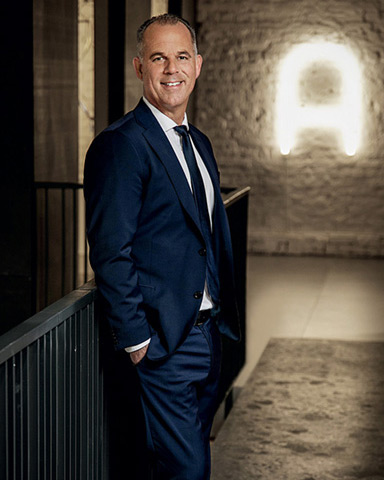
“I’ve been with this industry through several crises, and we’ll get through this one as well. The only question is what and how things will be afterwards. But we have the opportunity to develop that ‘afterwards’ by being ready to grow out of it. That’s what I’m doing now.”
Over the past two and a half decades, airBaltic has grown from a small airline into an inspiring role model for the industry. Here are some of the most significant milestones in the company’s history.
The airline is established in the early autumn of 1995 with the signing of a joint venture between the Latvian state and Scandinavian Airlines (SAS). On October 1, airBaltic operates its first commercial flight, from Riga to Stockholm, with the Saab SF340 aircraft, which has just 33 seats.
airBaltic opens the Cargo Department.
The airline’s first Fokker 50 arrives in Riga. A fleet of such aircraft faithfully serves airBaltic for the next 15 years
The first issue of airBaltic’s inflight magazine Baltic Outlook is published.
For several years, airBaltic’s fleet consists of three Avro RJ70 and three Fokker 50 aircraft.
airBaltic carries its one millionth passenger.
In addition to being well connected with SAS and offering multiple flights per day to Copenhagen and Stockholm, airBaltic opens direct routes from Riga to eight destinations in eastern and western Europe.
airBaltic launches ticket sales from its website via the internet.
The first Boeing 737-500 is introduced into the airBaltic fleet and operations.
Latvia joins the European Union and, thanks to the Open Skies policy, airBaltic is free to fly within Europe.
airBaltic begins direct flights from Vilnius to 11 European destinations and serves 27 routes from Riga.
airBaltic introduces a new corporate livery, which consists of an all-white fuselage and lime-green tailfin with the name ‘Baltic’ on it.
For the first time in its history, airBaltic carries more than one million passengers in a single year.
airBaltic launches its online check-in system. This is the first online check-in system in the Baltic states.
airBaltic begins training Boeing 737 pilots in a simulator at its home base in Riga.
airBaltic launches the e-voucher – the first prepaid airline ticket in northern Europe to be sold in supermarkets.
airBaltic opens an office in Tallinn, which is its tenth office. The airline also has offices in Riga (two), Vilnius, Klaipeda, Berlin, Kyiv, Minsk, Moscow, and Saint Petersburg.
airBaltic management purchases the SAS shares in the airline.
airBaltic launches its very own frequent flyer programme, BalticMiles. By partnering with leading banking, telecommunications, hospitality, travel, transport, and entertainment companies, it is the first pan-Baltic loyalty programme.
airBaltic opens the airBaltic Training Centre in Riga. It is one of the largest and most modern aviation training facilities in central and eastern Europe.
For the first time in history, a self-portrait by Leonardo da Vinci takes a flight. The so-called Lucan portrait travels on airBaltic from Rome via Riga to Tallinn.
airBaltic becomes the first airline in the world to sell roses 11 kilometres up in the sky.
For the first time in its history, the airline’s annual number of passengers exceeds three million.
The airBaltic supervisory board appoints Martin Gauss as the new CEO.
airBaltic becomes the world’s first airline to sell cars on board.
The Latvian government increases its shareholding in airBaltic to 99.8%, and airBaltic becomes a true national airline of Latvia.
airBaltic is recognised as the top employer in Latvia.
airBaltic celebrates 100,000 Facebook followers.
airBaltic operates a special flight from Riga to the Winter Olympics in Sochi with Latvian and Lithuanian athletes on board. The teams depart on a Boeing 737-500 specially painted with Olympic livery.
airBaltic becomes the world’s first airline to accept Bitcoin as a payment option.
airBaltic pilots go green with iPads. This saves about two million sheets of paper every year
For the first time, an OAG industry report rates airBaltic the world’s most punctual airline.
airBaltic is awarded a gold medal by ISPY for the quality of its cabin service
airBaltic welcomes the world’s first Bombardier CS300 (now Airbus A220-300) in Riga, becoming the global launch customer for this aircraft.
airBaltic launches a legendary Christmas greeting video with its new Bombardier CS300 aircraft performing The Nutcracker ballet, reaching all-time record engagement on social media.
airBaltic sets a new world record for turnaround as its newest Bombardier CS300 takes its first commercial flight only 50 minutes after delivery from Canada.
The airBaltic Training Pilot Academy begins accepting applications to train a new generation of pilots from the Baltic states.
airBaltic is the official air carrier for Pope Francis and the papal delegation during their official visit to the Baltic states.
airBaltic presents a gift to Latvia on its centenary – a special livery for Airbus A220-300 aircraft. On November 18, the plane takes part in the parade in honour of Latvia’s centenary.
airBaltic honours the 30th anniversary of the Baltic Way with a special gift – three aircraft painted in national liveries and a song dedicated to the event.
airBaltic becomes the first airline to obtain full-scope maintenance capability for Airbus A220-300 aircraft.
airBaltic regularly participates in various air shows, and in autumn of 2019 it takes its Airbus A220-300 on a tour around the Pacific region, visiting Vanuatu, Australia, New Zealand, New Caledonia, and Papua New Guinea.
airBaltic presents its Airbus A220 full flight simulator.
airBaltic carries more than five million passengers in 2019, or 22% more than the year before. This is the highest number of passengers carried in a single year in the airline’s history.
airBaltic Training opens a new hangar in Liepāja, Latvia. Students from the airBaltic Pilot Academy have been training in Liepāja already since the summer of 2018.
airBaltic becomes the first European airline to hand every customer on every flight an envelope containing a face mask and two disinfectant wipes.
airBaltic begins operating a single-type fleet consisting only of the modern Airbus A220-300 aircraft.
airBaltic opens a new educational programme for its staff – airBaltic Leaders for Future (ALFA) provides a solid foundation for airBaltic’s future development and growth through excellent leadership.
airBaltic’s fleet is rapidly and continually undergoing modernisation, and it now consists of only the world’s greenest commercial aircraft – the Airbus A220-300. At the end of this year the airline will receive its 25th jet, which will mean that half of its order from Airbus will be fulfilled. Check out these amazing facts about your plane.
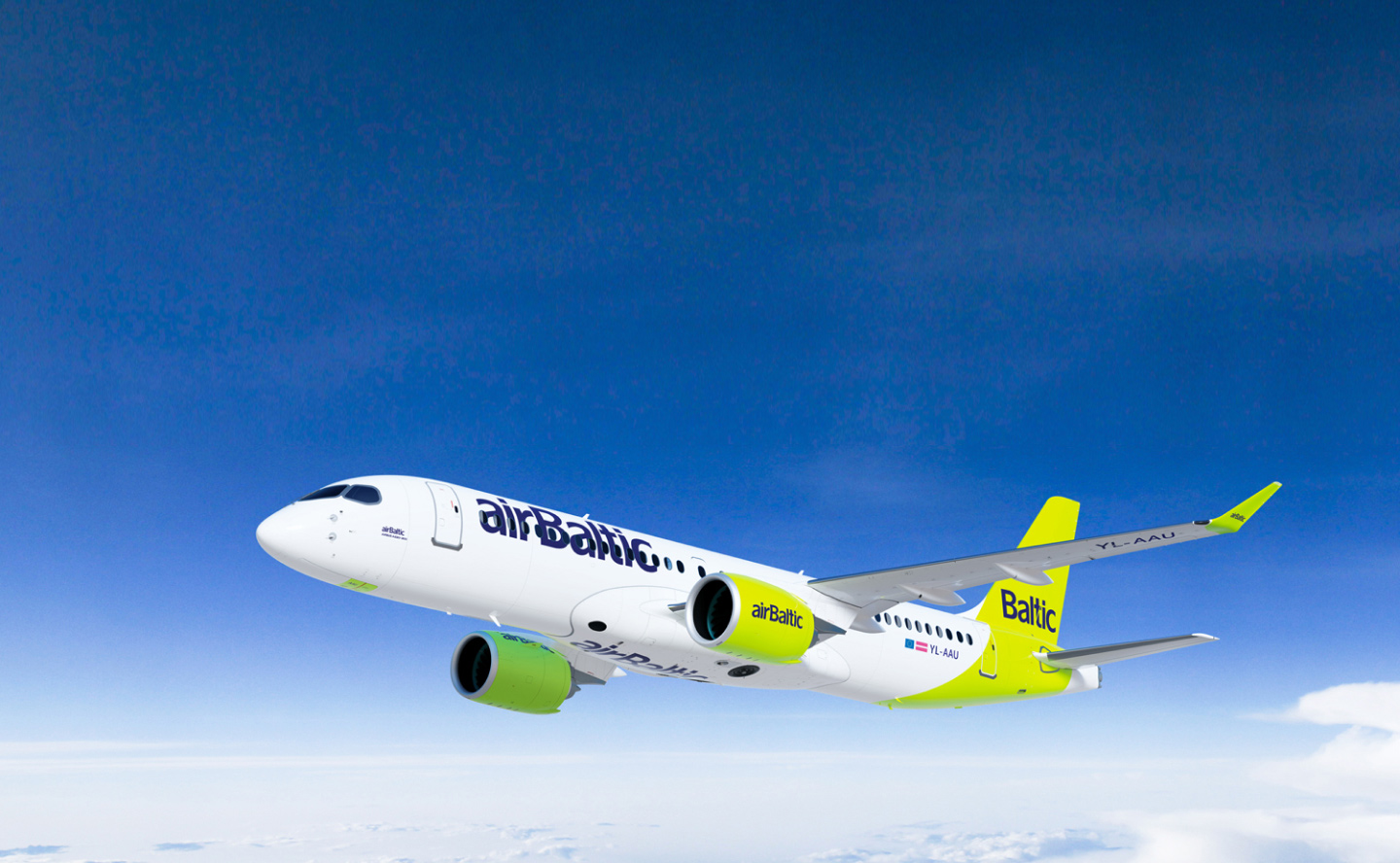
airBaltic has one of the most modern fleets flying across Europe. Three of its aircraft have been repainted in special liveries to reflect the unique DNA of airBaltic and the Baltics.
Read more| First flight: | June 29, 2019, to London |
| Number of flights till October, 2020: | 1374 |
| Number of destinations: | 57 |
| Kilometres flown till October, 2020: | 1 796 022 |
| Registration number: | YL-CSJ |


| First flight: | November 10, 2018, to Munich |
| Number of flights till October, 2020: | 2249 |
| Number of destinations: | 64 |
| Kilometres flown till October, 2020: | 3 243 341 |
| Registration number: | YL-CSL |
| First flight: | August 8, 2019,to Moscow |
| Number of flights till October, 2020: | 1171 |
| Number of destinations: | 57 |
| Kilometres flown till October, 2020: | 1 540 942 |
| Registration number: | YL-CSK |

There are eight people who have worked at airBaltic since the very beginning – 25 years. We encouraged them to come out of their offices and flight decks for a small, family-like gathering.
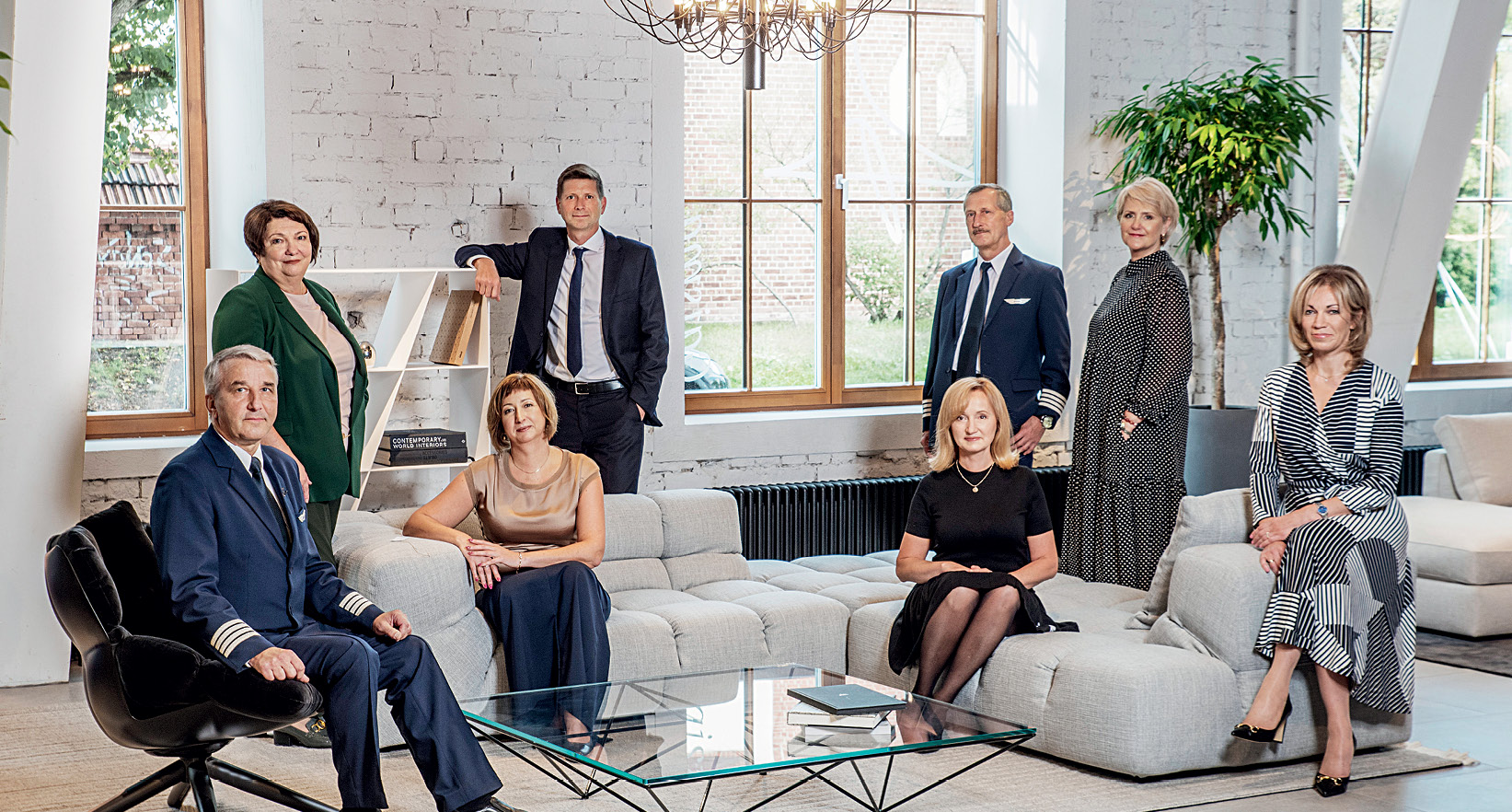
“At first, we were only four pilots and it was very challenging and interesting to build the company starting from zero. To write all the manuals and implement procedures in accordance with regulations, but still in our own way, the airBaltic way. I appreciate the opportunity to work and fly from my home country and that’s also what I’ve gained the most.”
“Establishing a wide network of contacts with people from different countries and cultures has been the biggest advantage. Working at airBaltic, I have been privileged to explore new ideas in different areas of the airline business and see how the realisation of them helped the company to progress to becoming the leading airline in the Baltic region. This brings a huge sense of satisfaction.”
“The company at which I began working 25 years ago has grown and changed, It has become a noteworthy, international company, and just witnessing that growth has been a high point. Also for myself, because that growth has given me a broader vision and broader knowledge, which, although very specific, is highly valued in the industry and in the field of international business.”
“People usually join the company at some point and see its development only from that point onward, but I’m lucky to have been here from the very beginning. Besides, working for one and the same company for 25 years is very rare nowadays. But that has given me a different perspective on what this airline and my colleagues mean to me.”
“I’ve flown almost my whole life, and I’ve always loved flying. I’ve never perceived it as just a job I have to do. I go to briefings to talk with my friends, and I head to the aircraft with joy. When flying with a good team, I don’t even feel tired afterwards and I return home in a good mood. When you’ve worked abroad, you no longer have the feeling that things are better elsewhere. Because things are good here.”
“I’ve learned to find the right solution and remain calm in stressful situations.” She began working at airBaltic 25 years ago as a flight attendant. She later graduated from college with a degree in public relations management but has not worked a single day in this profession. “I really like flying, and I continue to do so.”
She emphasises that her greatest benefit from working with the airline has been learning to adapt to circumstances, to change with the times, and to seek out opportunities to develop herself not only professionally but also personally. “That teaches you to react faster and better. To better fit in with the flow of time and trends. To move along with the times,” she explains.
“This company has also given me the opportunity to develop myself as a personality. I’m a leader by nature, and here I’ve been able to realise and develop that trait. For me, my work is definitely not simply work. It’s a very significant part of my life.”
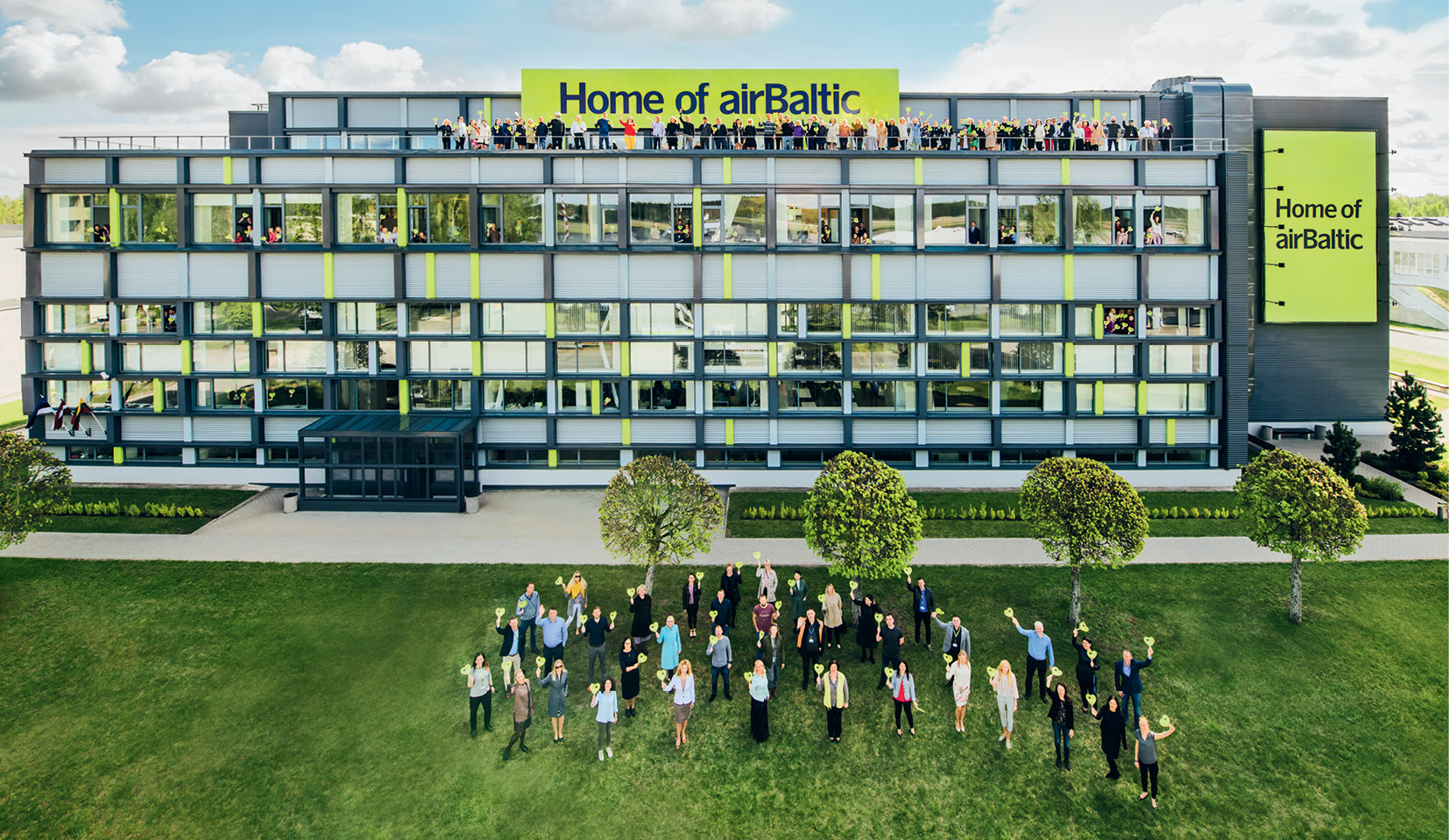
The people we meet on board the aircraft – our flight attendants – are only a small part of the airBaltic “house”. The airline consists of the President’s Office and several departments, each important in its own right and also important in collaboration with other departments in order to ensure flawless operations at airBaltic.
Did you know?
The Flight Support division also has a Fuel Efficiency Analyst, whose job is to manage, develop, and configure fuel efficiency software as well as to conduct data analysis and detect fuel consumption trends, monitor existing efficiency initiatives, and identify and implement new initiatives.
Did you know?
An avionics engineer conducts research to address manufacturers regarding problems associated with flight safety systems, landing gear, and electronic navigation systems.
Did you know?
The Load Control Coordinator ensures that cargo loads are distributed in the aircraft in such a way that the aircraft can be maintained at the correct pitch (angle) for a safe and efficient flight.
Did you know?
airBaltic has several representatives working abroad: in Russia, Belarus, Ukraine, Lithuania, and Estonia.
Did you know?
The history of revenue management can be traced back to the 1980s, originating in the airline industry.
Did you know?
A special unit produces content for airBaltic’s social media channels and provides full customer support. During the recent crisis caused by the pandemic, this team disseminated the newest company information, answered passenger inquiries on social media, and reassured the public that airBaltic is united with the whole aviation industry in building the new reality of air travel.
Did you know?
This department is the airline’s legal representative in business negotiations and in court. It has also participated in the issuing of bonds and the legal process of purchasing aircraft.
Did you know?
airBaltic transported 7577 pets last year, according to information gathered by the IT Department.
Did you know?
In 2019, airBaltic Cargo carried a record amount of cargo and mail – 14,800 tonnes, which was 21% more than the year before. This year, it organised the entire logistics chain for the delivery of face masks to Latvia following a request from its national health service to replenish critically low hospital reserves.
Did you know?
Last year, the airBaltic Training simulators were flown for a total of 9096 hours. (There were 8766 hours in the year 2019)
Did you know?
The Continuous Airworthiness Review Manager is the person who checks whether an aircraft or one of its component parts meets its type design and is in proper condition for safe operation.
Did you know?
For the next aircraft check, the Procurement Division has already received 400 requests for spare parts. Each part must be located in the market, its price must be negotiated, and delivery to Riga needs to be arranged – all of which is done by the Logistics Department.
Did you know?
The Quality Department monitors every flight of airBaltic, analysing over 2600 parameters for each flight.
Did you know?
The Scheduling and Slot Manager is one of the most specialised occupations in the aviation industry. There is typically only one or a couple of scheduling and slot management experts at any airline.
Did you know?
airBaltic’s Call Centre currently has 112 employees devoted to helping our passengers.
Did you know?
The Sustainable Workplace Manager position was established to guide our workplace and related processes in an even more sustainable direction.
Did you know?
Over the years, 187 people have worked in this division. 15% of the 33 people currently working in it are named Ilze.
Did you know?
In 2016, this division planned and oversaw the move of airBaltic employees from seven different buildings to one new office building, known as the House of airBaltic. The actual move was completed in three days, without any disruption to normal operations at the airline.
Did you know?
BCC operates in a cargo terminal with 1600sq/m of heated warehouse space and is capable of processing any type of airfreight.
According to fashion experts, the best airlines choose a balance of retro styling and modern cuts to give their pilots and flight attendants the most glamorous and professional looks possible.
Read more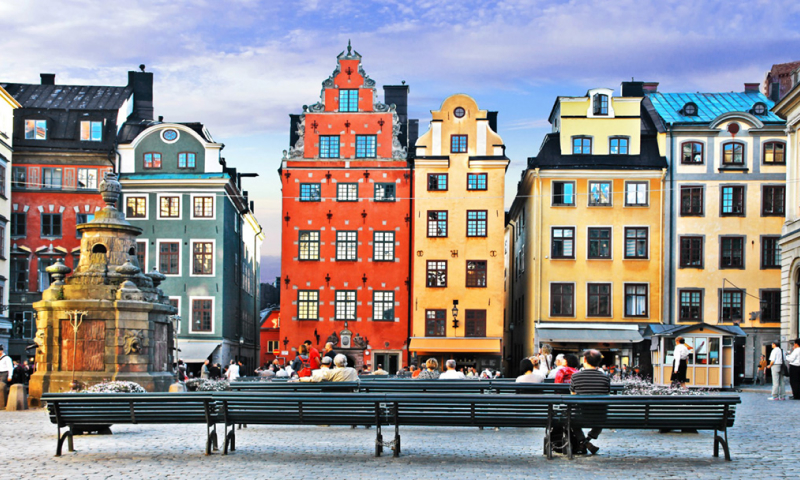
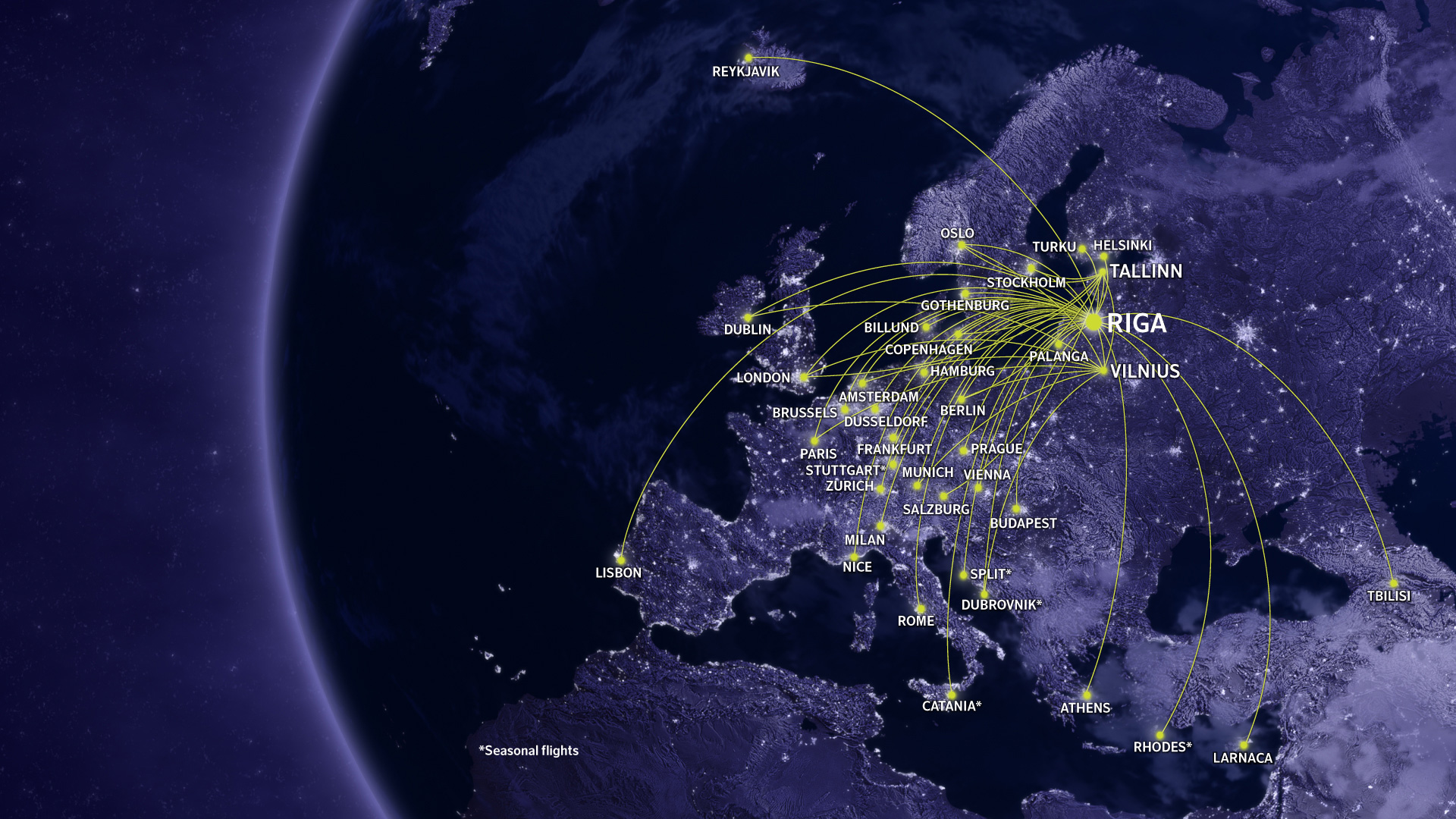
Your most-liked airBaltic social media post
With the help of various social media, airBaltic has reached 582% more clients over the past five years, while its virtual Facebook chatbot has served almost 22,000 clients. airBaltic stands out among its much bigger competitors in terms of, for example, its Facebook engagement rate, and it successfully fulfils its vision of clients buying flights after visiting its social media platforms.
1.
On August 8, 2019, Lithuania was especially honoured with the unveiling of the Airbus A220-300 named Vilnius and painted in the colours of the Lithuanian flag. This post received an impressive 19,000 likes on Facebook.
2.
In second place, with 14,000 likes, was the August 23, 2019, ‘Proud to be Baltic’ post about the special event in honour of the 30th anniversary of the Baltic Way. All three aircraft painted in the colours of the Baltic flags could be seen together.
3.
And in third place, with 4500 likes, the photo gallery published on December 17, 2019, in which airBaltic introduced its new 2020 calendar. Talented Latvian photographer Aiga Rēdmane took the colourful calendar photos of airBaltic’s employees posing with the specially painted Airbus A220-300 aircraft.
1.
airBaltic’s ambassadors are to thank for some of the most beautiful photos posted on the airline’s Instagram account. For example, the most popular image since August 2019 – earning almost 30,000 hearts, or likes – is a picture taken by ambassador Olga Bogdanova on the Côte d’Azur in France.
2.
The second most popular photo on Instagram, with more than 20,000 likes, is Valentino Valkaj’s picture of the northern lights. This breathtaking natural phenomenon can be seen at several airBaltic destinations, including Finland and Iceland.
3.
And it is a photo taken in Iceland that takes third place, with more than 16,000 hearts. Taken by photographer Pavel Matveev, the image contains everything a traveller can dream of: Iceland’s spectacular nature, mighty mountains, and a warm drink.
1.
The all-time most popular video on airBaltic’s YouTube channel was made and published two years ago. It’s only a minute and a half long and quite romantic, showing an airBaltic pilot proposing to his beloved – who’s also a pilot! – just a moment after landing. Almost five million people have watched the video!
2.
The song ‘Via Baltica’, airBaltic’s beautiful and moving tribute to the 30th anniversary of the Baltic Way sung in all three languages of the Baltic states, brought together artists from Latvia, Lithuania, and Estonia: Jānis Šipkēvics, Reinis Sējāns, Jazzu, and Ewert Sundja. The airline’s specially painted aircraft also appear in the video, which has been watched by 33,000 people.
3.
With more than 2500 views, the third most watched video of the past year also honours the 30th anniversary of the Baltic Way. The airBaltic team and guests celebrated the event on August 21, 2019. Proud to be Baltic!